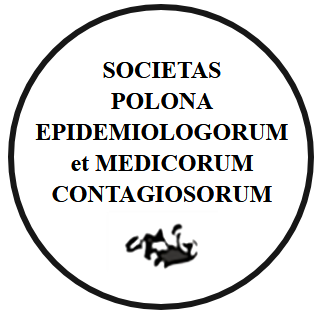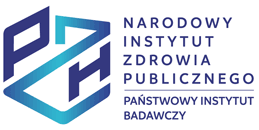ABSTRACT
AIM. The aim of the study is to assess the epidemiological situation of salmonellosis in Poland in 2020 compared with previous years.
MATERIAL AND METHODS. The epidemiological situation was assessed on the basis of data provided to the Department of Epidemiology of Infectious Diseases and Surveillance of the NIPH NIH-NRI by sanitary-epidemiological stations through the EpiBaza System and the Registry of Epidemic Outbreaks System (ROE), as well as on the basis of data published in the annual bulletin “Infectious Diseases and Poisoning in Poland in 2020” (NIPH NIH-NRI, GIS, Warsaw, 2021) and from information received from laboratories of sanitary-epidemiological stations and data from the Demographic Research Department of the Statistics Poland.
RESULTS. In Poland in 2020, in the sanitary-epidemiological surveillance registered a total of 5,470 cases of salmonellosis, 5,302 cases of intestinal salmonellosis, and the remaining 168 cases of extra-intestinal salmonellosis. The incidence per 100,000 population was 14.3 for total salmonellosis, 13.8 for intestinal salmonellosis and 0.44 for extra-intestinal salmonellosis. Sanitary-epidemiological stations registered 5,349 confirmed cases and 121 probable cases of salmonellosis. Due to intestinal salmonellosis, 63.9% of all patients were hospitalized, while for extra-intestinal salmonellosis 153 patients or 91.1% of cases, were hospitalized.
The increase in the number of salmonellosis cases in 2020 started in June, while the peak of the incidence was in August. Among the voivodeships, the highest incidence of salmonellosis was registered in the Podkarpackie voivodeship 33.3/100,000 population, the lowest in Zachodniopomorskie 6.1/100,000 population. Cases in the 0-4 age group accounted for 45.2% of all salmonellosis cases in 2020. Among extra-intestinal salmonellosis, 63.1% were people aged 60+. Sanitary-epidemiological stations registered 131 food poisoning outbreaks caused by Salmonella bacilli in the ROE system, 108 of these outbreaks were caused by the Enteritidis serotype. In 2020, the most common serotypes were S. Enteritidis 70% of all recorded salmonellosis, S. Typhimurium 1.9%, and S. Infantis 0.54%. There were 9 deaths due to Salmonella infection.
CONCLUSIONS. The COVID-19 pandemic and the associated restrictions introduced in the country, as well as increased hygiene through more frequent washing and disinfection of hands, could have contributed to a reduction of almost 69% in the number of salmonellosis cases registered in 2020, in Poland, compared to 2019.
This is a 82% decrease in relation to 2018. There was also a decrease in the number of food poisoning outbreaks caused by Salmonella bacilli, while at the same time their percentage in the total number of outbreaks increased.
On the one hand, the implemented restrictions could have had an impact on the decrease in the number of cases and outbreaks, on the other hand, worse access to medical care and diagnostics, most likely deepened the underestimation of these cases in the country observed for years, and distorted the real picture of the situation.
STRESZCZENIE
CEL. Celem pracy jest ocena sytuacji epidemiologicznej zachorowań na salmonelozy w Polsce w 2020 roku w porównaniu z poprzednimi latami.
MATERIAŁ I METODY. Ocenę sytuacji epidemiologicznej przeprowadzono na podstawie danych przekazanych do Zakładu Epidemiologii Chorób Zakaźnych i Nadzoru NIZP PZH - PIB przez stacje sanitarno-epidemiologiczne za pośrednictwem Systemu EpiBaza oraz systemu Rejestr Ognisk Epidemicznych (ROE), a także na podstawie danych opublikowanych w rocznym biuletynie „Choroby zakaźne i zatrucia w Polsce w 2020 roku” (NIZP PZH-PIB, GIS, Warszawa, 2021) oraz z informacji uzyskanych z laboratoriów stacji sanitarno-epidemiologicznych i danych Departamentu Badań Demograficznych Głównego Urzędu Statystycznego.
WYNIKI. W Polsce w 2020 roku w nadzorze sanitarno-epidemiologicznym zarejestrowano łącznie 5 470 przypadków salmoneloz, 5 302 to przypadki salmonelozy jelitowej, pozostałe 168 to salmoneloza pozajelitowa.
Zapadalność na 100 tys. populacji wyniosła dla salmoneloz ogółem 14,3, dla salmoneloz jelitowych 13,8 a dla salmoneloz pozajelitowych 0,44. Stacje sanitarno-epidemiologiczne zarejestrowały 5 349 przypadków potwierdzonych oraz 121 przypadków prawdopodobnych salmoneloz. Z powodu salmoneloz jelitowych hospitalizowano 63,9% wszystkich chorych, natomiast z powodu salmoneloz pozajelitowych 153 osoby czyli 91,1% przypadków. Wzrost liczby przypadków salmoneloz w 2020 roku rozpoczął się w czerwcu, natomiast szczyt zachorowań miał miejsce w sierpniu. Wśród województw najwyższą zapadalność na salmonelozy zarejestrowano w województwie podkarpackim 33,3/100 tys. ludności, najniższą w województwie zachodniopomorskim 6,1/100 tys. ludności. Zachorowania w przedziale wieku 0-4 stanowiły w 2020 roku 45,2% wszystkich przypadków salmoneloz. Wśród salmoneloz pozajelitowych 63,1% stanowiły osoby w wieku 60+. Stacje sanitarno-epidemiologiczne zarejestrowały w systemie ROE 131 ognisk zatruć pokarmowych spowodowanych pałeczkami z rodzaju Salmonella, 108 z tych ognisk zostało wywołanych serotypem Enteritidis. W 2020 roku najczęstszymi serotypami były S. Enteritidis – 70% wszystkich zarejestrowanych salmoneloz, S. Typhimurium – 1,9%, oraz S. Infantis – 0,54%. Odnotowano 9 zgonów z powodu zakażenia bakteriami Salmonella.
WNIOSKI. Pandemia COVID-19 i związane z nią wprowadzone w kraju restrykcje, a także zwiększona higiena poprzez częstsze mycie oraz dezynfekcję rąk mogły przyczynić się do zmniejszenia o prawie 69% liczby zarejestrowanych w 2020 roku w Polsce przypadków salmoneloz, w porównaniu do roku 2019. W odniesieniu do roku 2018 jest to spadek o 82%. Odnotowano również spadek liczby ognisk zatruć pokarmowych wywołanych pałeczkami z rodzaju Salmonella, natomiast jednocześnie zwiększył się ich odsetek w ogólnej liczbie ognisk.
Z jednej strony wdrożone obostrzenia mogły mieć wpływ na zmniejszenie się liczby przypadków oraz ognisk, z drugiej strony gorszy dostęp do opieki medycznej i diagnostyki, najprawdopodobniej pogłębił obserwowane od lat niedoszacowanie tych przypadków w kraju i zaburzyły rzeczywisty obraz sytuacji.
You can change cookies settings in your browser. Restricted use of cookies in the browser configuration may affect some functionalities of the website.





